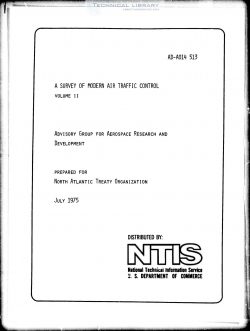AGARD-AG-209-V2
- Version
- 244 Downloads
- 37.28 MB File Size
- 1 File Count
- February 28, 2017 Create Date
- February 28, 2017 Last Updated
A Survey of Modern Air Traffic Control

Radio systems are particularly suited to deliver data required for navigational guidance of a vehicle. Numerous problems of position-fixing and navigation cannot be solved simpler and better by any other aid. Depending on the type and combination Of the systems employed, various data Can be obtained: stance between vehicle and a ground—based system; difference between two distances; angle between a reference Sur— face and a surface or straight line intersecting the center of the ground system; dif— If two (or, in space, three) independent reference ference frou a selected angle. data are available. the can be used t u compute the coordinates Of the aircraft's po— sition. In addition, t e ground speed and the altitude above ground can be measured. Radio systems used in communication gre designed to supply the same information at any location within a given area. Radio systems used for position fixing, however, should provide information that differs from location to location and should provide data associated to the instantaneous position of the vehicle. The coverage of a radio location system (NAVAID) is therefore not determined by the range in the usual sense, but by the usefulness of the navigational information. The quantities characterizing a radio field and capable Of being measured are its amplitude, phase and frequency. The change of one or more of these quanti ties with the position in the radio field constitutes the basis of any radio navigation system. The distribution of these field quantities in space is called the amplitude-, phase—, or frequency-pattern. The properties of such patterns can be varied in wide limits and adapted to special requirements. Radio methods employing this basis can be con— In the first case, a transmitter ceived as transmitter- or receiver-navaid methods. produces a radio field that contains, at any point of the field, the location-fixing data related to this point. This data can be received and processed by any number of vehicles aimultaneously. In the latter case, the vehicle transmits a signal identi— fying the vehicle, but containing no position information; this signal is received and processed by an equivalent ground system. The result of the evaluation can be trans— mitted to the vehicle. In this Case, only one vehicle can be served at a given time. A typical example is the ground direction finder. The tranc:zi "er—navaid and receiver— navaid methods are on principle equivalent. The choice of the one or the other method depends on the general problem, operational requirements and technological feasibili- ties. There are cases, however, where a reversion is a priori precluded. An example are the long—distance methods where it is impossible to install antennas and trans- mitter pover in an aircraft required to cover the large range. On the other hand at some navaids, which originally were designed as a pure transmitting system, the re— quirements on the airborne receiver became more and more stringent In the course of time. Hence more advantages may be seen in the conversion to a receiving system, where the groundstation is equipped with high—grade receiving and signal processing uni ts, whereas the installation aboard the aircraft Is reduced on a relatively simple transmitter.
| File | Action |
|---|---|
| AGARD-AG-209-V2 A Survey of Modern Air Traffic Control.pdf | Download |

Comment On This Post